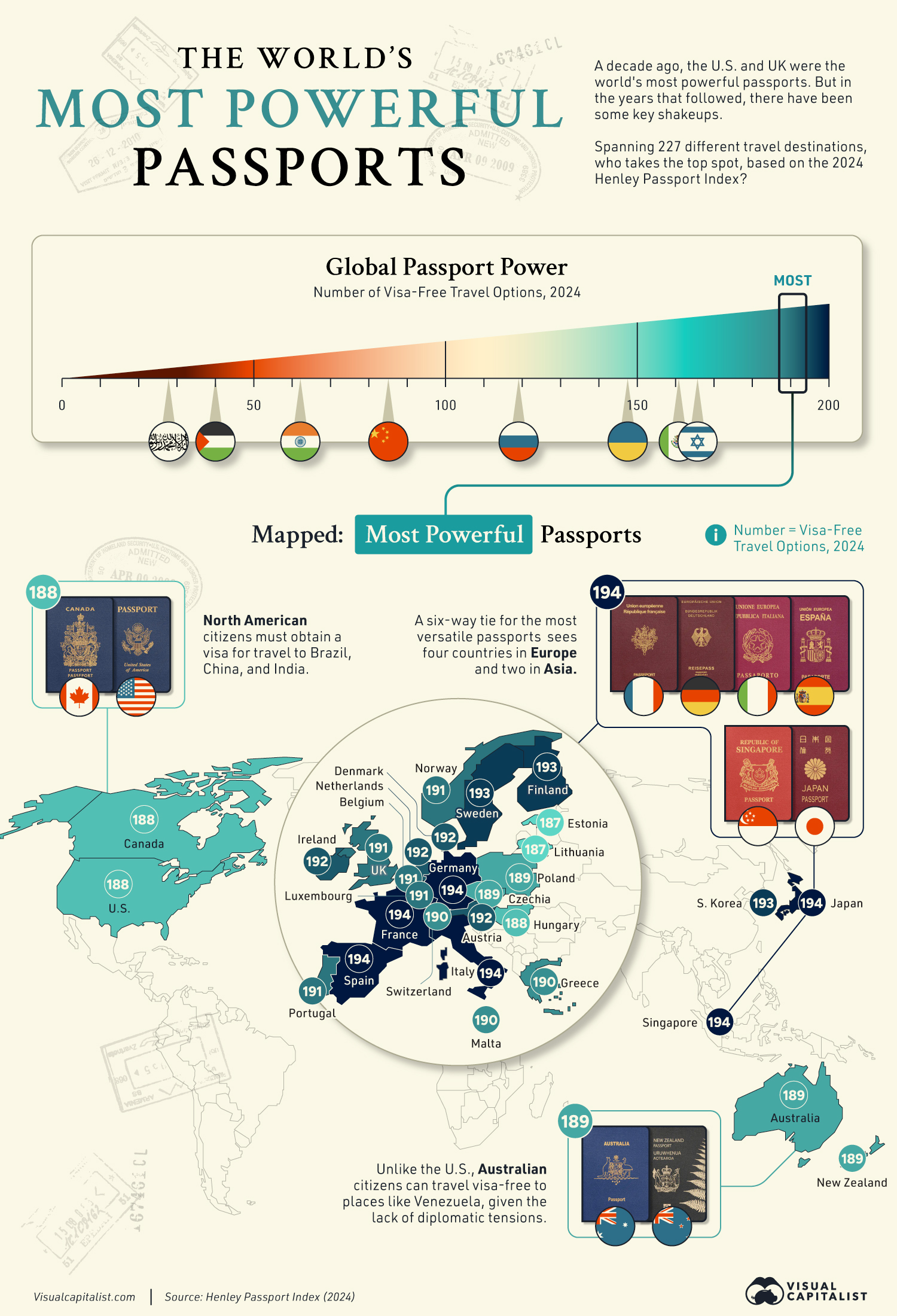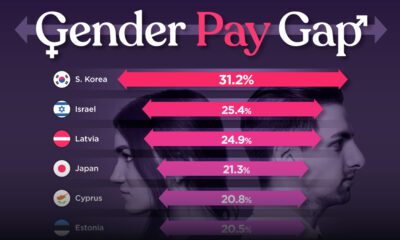Maps
The World’s Most Powerful Passports in 2024
![]() See this visualization first on the Voronoi app.
See this visualization first on the Voronoi app.
The World’s Most Powerful Passports in 2024
This was originally posted on our Voronoi app. Download the app for free on iOS or Android and discover incredible data-driven charts from a variety of trusted sources.
People around the world enjoy significantly greater travel freedom than they did just a couple decades ago.
In 2006, people could travel visa-free to 58 countries on average, while today that number has jumped to 111 destinations. Even in the last year, French, German, Spanish, and Italian citizens can now travel visa-free to three new countries.
This graphic shows the most powerful passports in 2024, with data from the annual Henley & Partners Passport Index.
Passport Strength in 2024
The world’s top passport is shared in a six-way tie, with visa-free access to 194 countries.
| Ranking | Country | Number of Countries with Visa-Free Access |
|---|---|---|
| 1 | 🇫🇷 France | 194 |
| 1 | 🇩🇪 Germany | 194 |
| 1 | 🇮🇹 Italy | 194 |
| 1 | 🇯🇵 Japan | 194 |
| 1 | 🇸🇬 Singapore | 194 |
| 1 | 🇪🇸 Spain | 194 |
| 2 | 🇫🇮 Finland | 193 |
| 2 | 🇰🇷 South Korea | 193 |
| 2 | 🇸🇪 Sweden | 193 |
| 3 | 🇦🇹 Austria | 192 |
| 3 | 🇩🇰 Denmark | 192 |
| 3 | 🇮🇪 Ireland | 192 |
| 3 | 🇳🇱 Netherlands | 192 |
| 4 | 🇧🇪 Belgium | 191 |
| 4 | 🇱🇺 Luxembourg | 191 |
| 4 | 🇳🇴 Norway | 191 |
| 4 | 🇵🇹 Portugal | 191 |
| 4 | 🇬🇧 UK | 191 |
| 5 | 🇬🇷 Greece | 190 |
| 5 | 🇲🇹 Malta | 190 |
| 5 | 🇨🇭 Switzerland | 190 |
| 6 | 🇦🇺 Australia | 189 |
| 6 | 🇨🇿 Czechia | 189 |
| 6 | 🇳🇿 New Zealand | 189 |
| 6 | 🇵🇱 Poland | 189 |
| 7 | 🇨🇦 Canada | 188 |
| 7 | 🇭🇺 Hungary | 188 |
| 7 | 🇺🇸 U.S. | 188 |
| 8 | 🇪🇪 Estonia | 187 |
| 8 | 🇱🇹 Lithuania | 187 |
While Japan and Singapore ranked first for the last five years, four European countries—France, Germany, Italy, and Spain— climbed the ranks this year.
This comes as China granted visa-free access to these European countries and 50 other nations in efforts to revive tourism in a post-pandemic era. This follows a broader trend of countries waiving visas to encourage travel and boost economic activity. In the last eight years, for instance, both Germany and Singapore were granted visa-free travel to 35 new countries.
Finland, Sweden, and South Korea tie for second place in the rankings. In fact, the latter country has one of the highest numbers of visa waiver agreements in the world.
The U.S. ranks in seventh, one of its worst relative rankings ever. Over the last decade, its standing has fallen in rank given diplomatic tensions and its relative lack of openness to foreign tourists. For example, Brazil recently removed visa-free access to U.S. citizens for reciprocity reasons—the U.S. requires Brazilians to have a visa to travel to the country.
From a regional perspective, 23 of the top 30 passports are in Europe and the UK, three are in Asia, while two are in both North America and Oceania.
Changes Ahead
After many years in the works, U.S. travelers will need a visa to travel to Europe in 2025.
In most cases, applications should be processed in minutes, but some may take as long as a few weeks. Travelers in Canada, Mexico, and South America will also be required to fill out the application. The good news is that the visa will be valid for three years or the date a passport expires, depending on which one happens first.
By contrast, Indonesia is discussing allowing visa-free access to 20 countries to encourage tourism and investment in the country. It is the second Asian nation after Singapore that is eyeing visa waivers to China. Recently, Thailand and Malaysia have provided the world’s second-largest economy visa-free access thanks to its role as a key driver of tourism in these countries.
Maps
The Largest Earthquakes in the New York Area (1970-2024)
The earthquake that shook buildings across New York in April 2024 was the third-largest quake in the Northeast U.S. over the past 50 years.

The Largest Earthquakes in the New York Area
This was originally posted on our Voronoi app. Download the app for free on Apple or Android and discover incredible data-driven charts from a variety of trusted sources.
The 4.8 magnitude earthquake that shook buildings across New York on Friday, April 5th, 2024 was the third-largest quake in the U.S. Northeast area over the past 50 years.
In this map, we illustrate earthquakes with a magnitude of 4.0 or greater recorded in the Northeastern U.S. since 1970, according to the United States Geological Survey (USGS).
Shallow Quakes and Older Buildings
The earthquake that struck the U.S. Northeast in April 2024 was felt by millions of people from Washington, D.C., to north of Boston. It even caused a full ground stop at Newark Airport.
The quake, occurring just 5 km beneath the Earth’s surface, was considered shallow, which is what contributed to more intense shaking at the surface.
According to the USGS, rocks in the eastern U.S. are significantly older, denser, and harder than those on the western side, compressed by time. This makes them more efficient conduits for seismic energy. Additionally, buildings in the Northeast tend to be older and may not adhere to the latest earthquake codes.
Despite disrupting work and school life, the earthquake was considered minor, according to the Michigan Technological University magnitude scale:
| Magnitude | Earthquake Effects | Estimated Number Each Year |
|---|---|---|
| 2.5 or less | Usually not felt, but can be recorded by seismograph. | Millions |
| 2.5 to 5.4 | Often felt, but only causes minor damage. | 500,000 |
| 5.5 to 6.0 | Slight damage to buildings and other structures. | 350 |
| 6.1 to 6.9 | May cause a lot of damage in very populated areas. | 100 |
| 7.0 to 7.9 | Major earthquake. Serious damage. | 10-15 |
| 8.0 or greater | Great earthquake. Can totally destroy communities near the epicenter. | One every year or two |
The largest earthquake felt in the area over the past 50 years was a 5.3 magnitude quake that occurred in Au Sable Forks, New York, in 2002. It damaged houses and cracked roads in a remote corner of the Adirondack Mountains, but caused no injuries.
| Date | Magnitude | Location | State |
|---|---|---|---|
| April 20, 2002 | 5.3 | Au Sable Forks | New York |
| October 7, 1983 | 5.1 | Newcomb | New York |
| April 5, 2024 | 4.8 | Whitehouse Station | New Jersey |
| October 16, 2012 | 4.7 | Hollis Center | Maine |
| January 16, 1994 | 4.6 | Sinking Spring | Pennsylvania |
| January 19, 1982 | 4.5 | Sanbornton | New Hampshire |
| September 25, 1998 | 4.5 | Adamsville | Pennsylvania |
| June 9, 1975 | 4.2 | Altona | New York |
| May 29, 1983 | 4.2 | Peru | Maine |
| April 23, 1984 | 4.2 | Conestoga | Pennsylvania |
| January 16, 1994 | 4.2 | Sinking Spring | Pennsylvania |
| November 3, 1975 | 4 | Long Lake | New York |
| June 17, 1991 | 4 | Worcester | New York |
The largest earthquake in U.S. history, however, was the 1964 Good Friday quake in Alaska, measuring 9.2 magnitude and killing 131 people.
-

 Education1 week ago
Education1 week agoHow Hard Is It to Get Into an Ivy League School?
-

 Technology2 weeks ago
Technology2 weeks agoRanked: Semiconductor Companies by Industry Revenue Share
-

 Markets2 weeks ago
Markets2 weeks agoRanked: The World’s Top Flight Routes, by Revenue
-

 Demographics2 weeks ago
Demographics2 weeks agoPopulation Projections: The World’s 6 Largest Countries in 2075
-

 Markets2 weeks ago
Markets2 weeks agoThe Top 10 States by Real GDP Growth in 2023
-

 Demographics2 weeks ago
Demographics2 weeks agoThe Smallest Gender Wage Gaps in OECD Countries
-

 Economy2 weeks ago
Economy2 weeks agoWhere U.S. Inflation Hit the Hardest in March 2024
-

 Environment2 weeks ago
Environment2 weeks agoTop Countries By Forest Growth Since 2001















